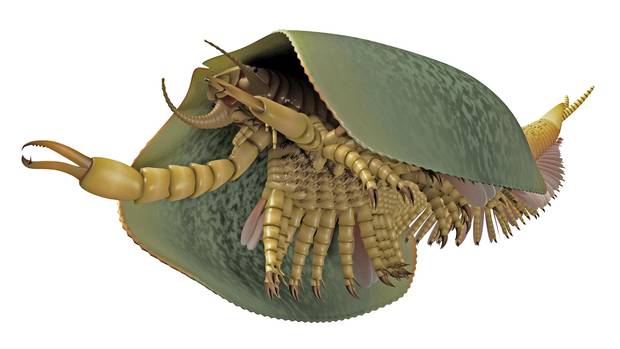@WFS,World Fossil Society,Riffin T Sajeev,Russel T Sajeev,Tokummia Katalepsis
The newest creature discovered at the Burgess Shale fossil site in B.C. looks like it’s part centipede, part crab and part can-opener.
Meet the tokummia katalepsis, a Cambrian-era predator, found by paleontologists from the University of Toronto and the Royal Ontario Museum.The team released news of the tokummia and 21 other creatures found in the same fossil repository on Wednesday in the journal Nature.

A 3-D rendering of the tokummia katalepsis from the Royal Ontario Museum in Toronto shows its serrated pincers, which were too fragile to feed on shelled animals.(Royal Ontario Museum)
“It can be interesting in paleontology, how much can depend on one feature,” Dr. Aria said.
He said the discovery of the tokummia’s pincers is important because it gives
a timeline of the evolution of the larger animal group, anthropods. The fossils date back more than five hundred million years.
Jean-Bernard Caron, senior curator of invertebrate palaeontology at the Royal Ontario Museum and associate professor at U of T, said the tokummia, at more than 10-centimetres long, was one of the largest predators of its time and lived at the bottom of the sea.
“For today’s standards, they are very small, but you have to imagine they were very large at the time when the other animals were the size of my thumbnail,” Prof. Caron said.
According to Dr. Aria, the tokummia’s body was covered by a broad two-piece shell-like structure and it had numerous legs. The pincers were delicate, meaning they may have been too fragile to feed on shelled animals, therefore they adapted to capture soft prey and tear them apart before eating them.
The discovery of the mandibles wouldn’t have been possible if not for the quality of fossils.
“You need preservation that’s so exceptional that it gives you access to the tiniest of features,” Dr. Aria said.
Prof. Caron said the fossils were so well-preserved the researchers were able to dissect the findings.The researchers cut into the fossils with micro-jack hammers to uncover
smaller features. This allowed researchers to show the mandibles that were hidden behind the tokummia’s flattened shell.
“It’s really unusual to dissect fossils,” Prof. Caron says. “But without dissection, we would not have been able to find the smoking gun of the story – the mandibles.”
Robert Dalrymple, an active retired professor of paleobiology at Queen’s University, said the preservation is among the most impressive aspects of the study.
“To find such a beautiful, fully preserved specimen such as this is extremely rare,” Dr. Dalrymple said.
“[For the researchers to] work out all of the details of the organisms appearance in three dimensions from the squashed and flattened two-dimensional impression represents impressive work.”
Courtesy: Article By Luke Carroll,http://www.theglobeandmail.com
Key: WFS,World Fossil Society,Riffin T Sajeev,Russel T Sajeev



 April 27th, 2017
April 27th, 2017  Riffin
Riffin  Posted in
Posted in  Tags:
Tags: 